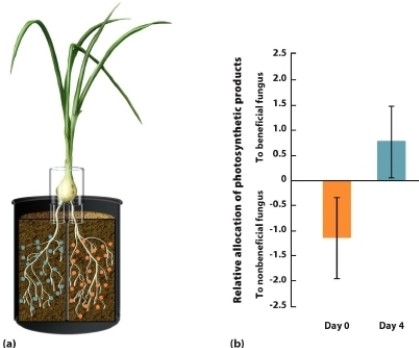Multiple Choice
 (Figure 17.18) A group of researchers grew plants so that half of their roots were in soil with a fungus that provides benefits to the plants and the other half were in soil with a fungus that did not provide benefits to the plants. After 9 weeks of growth, they provided the plants with carbon dioxide containing a rare isotope of carbon. For four days, they evaluated how much of the carbon went to the beneficial fungus and how much of the carbon went to the nonbeneficial fungus. Some of their results are presented in the figure. Which statement(s) about this experiment is/are CORRECT?
(Figure 17.18) A group of researchers grew plants so that half of their roots were in soil with a fungus that provides benefits to the plants and the other half were in soil with a fungus that did not provide benefits to the plants. After 9 weeks of growth, they provided the plants with carbon dioxide containing a rare isotope of carbon. For four days, they evaluated how much of the carbon went to the beneficial fungus and how much of the carbon went to the nonbeneficial fungus. Some of their results are presented in the figure. Which statement(s) about this experiment is/are CORRECT?
I. At the experiment's start, the nonbeneficial fungus was taking resources from the plant.
II. After 4 days, the plant provided more resources to the beneficial fungus.
III. This is an example of how species can prevent cheating in mutualisms.
A) I only
B) II only
C) III only
D) I and II only
E) I, II, and III
Correct Answer:

Verified
Correct Answer:
Verified
Q33: Consider a simple food web consisting of
Q34: Which of the following situations is/are likely
Q35: If cleaner fish went extinct, damselfish would<br>A)
Q36: You are studying a plant species that
Q37: Plants like beans, peas, and alfalfa (legumes)
Q39: <img src="https://d2lvgg3v3hfg70.cloudfront.net/TB7728/.jpg" alt=" (Figure 17.22) Researchers
Q40: If Rhizobium bacteria were to go extinct,
Q41: Describe why the relationship between the pitcher
Q42: A specialist is a mutualist that<br>A) interacts
Q43: A mutualist that interacts with many other